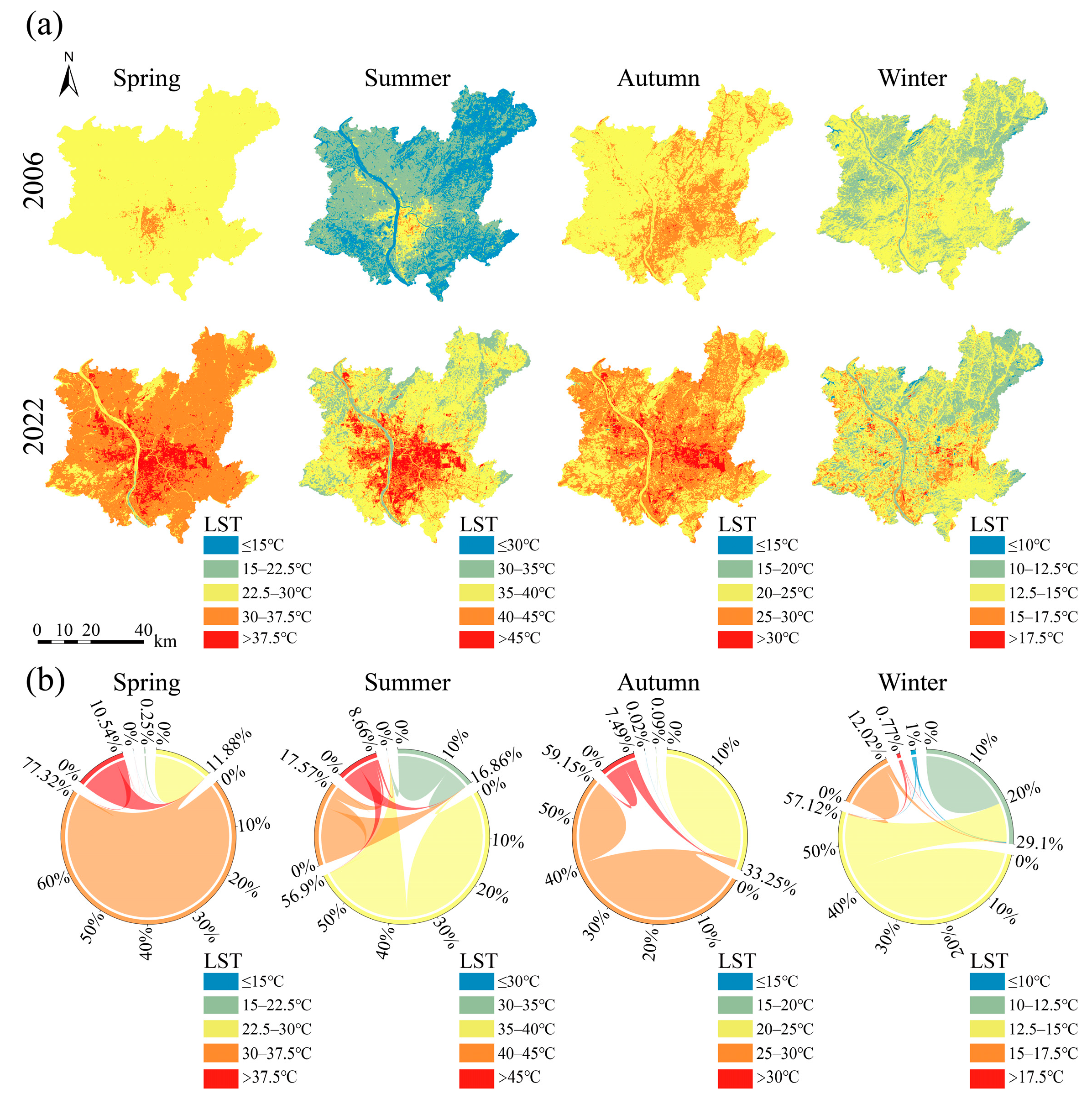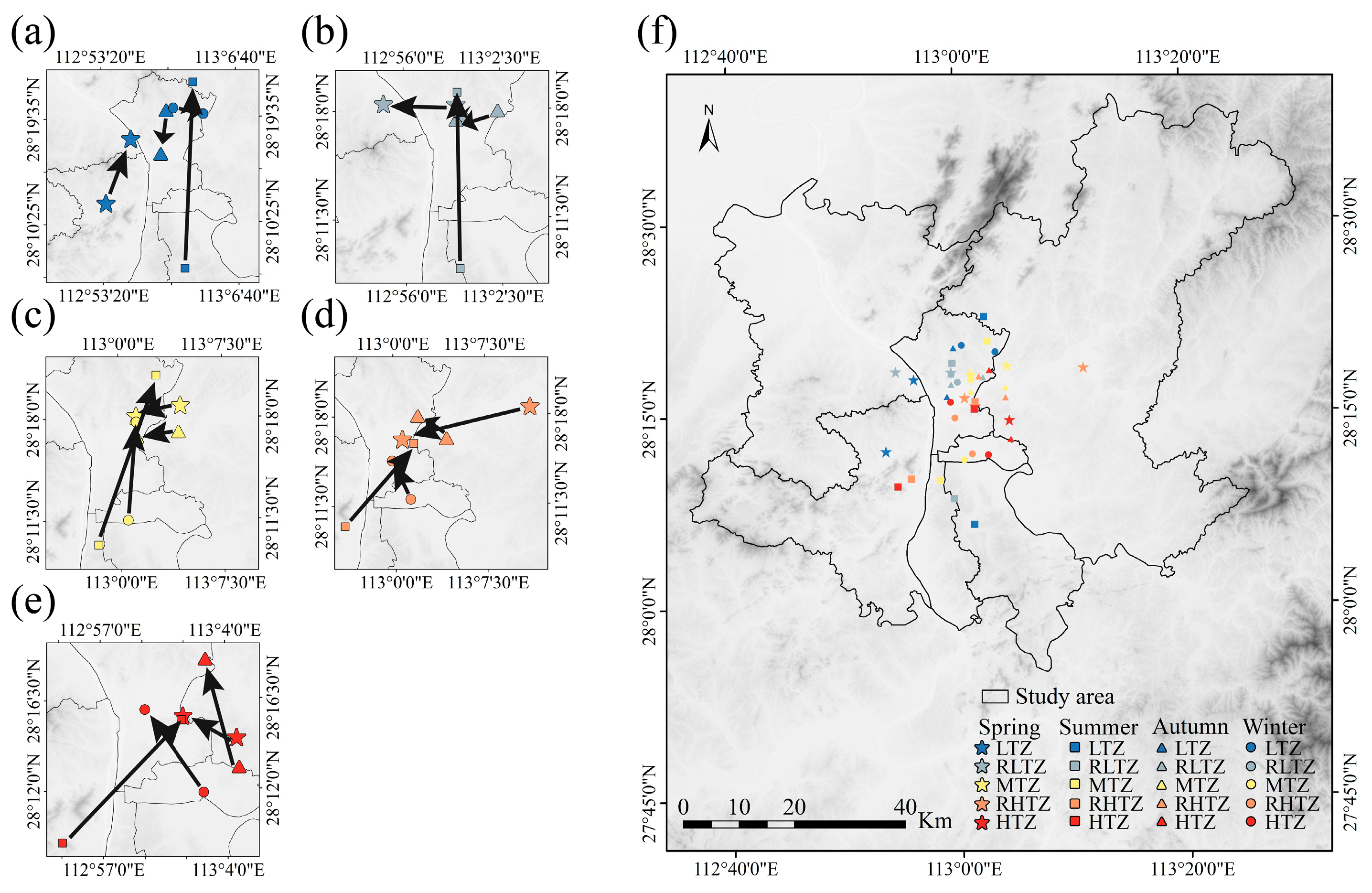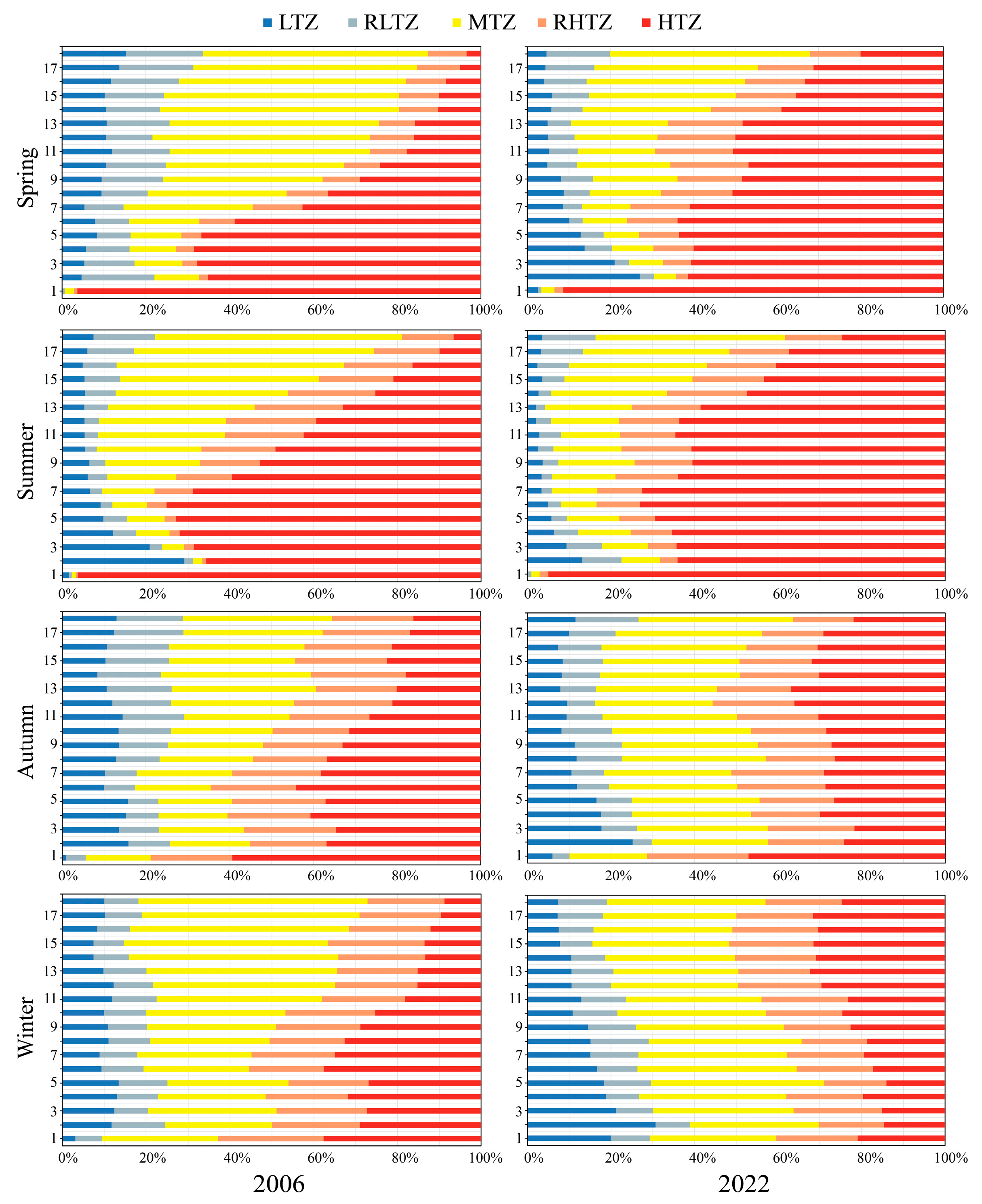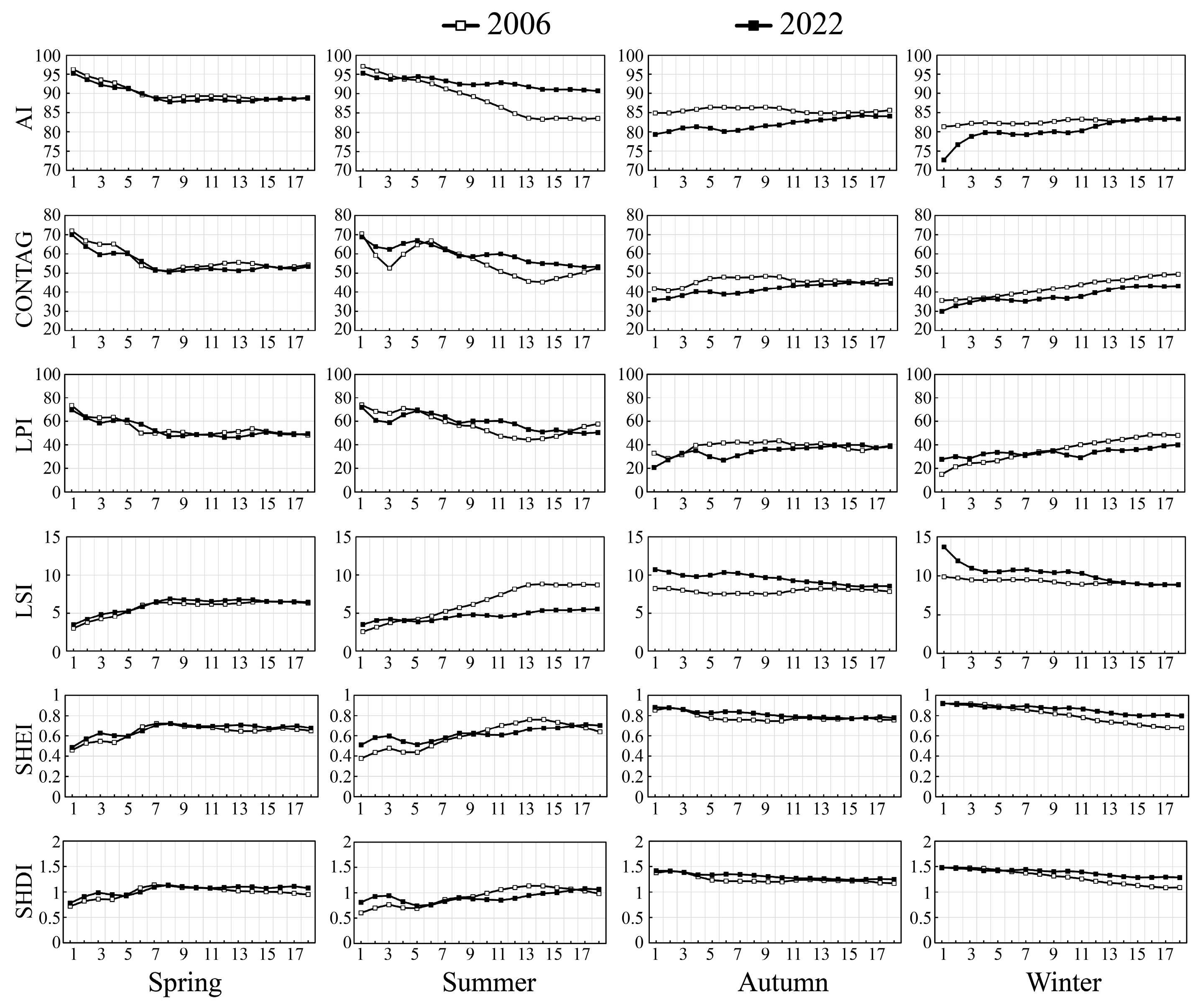Seasonal Spatiotemporal Dynamics and Gradients of the Urban Heat Island Effect in Subtropical Furnace Megacity
Abstract
:1. Introduction
2. Materials and Methods
2.1. Study Area
2.2. Datasets
2.3. Methods
2.3.1. Land Surface Temperature Retrieval and Classification of UHI
2.3.2. Spatiotemporal Dynamics of the UHI
2.3.3. Gradient Analysis of the UHI
3. Results
3.1. Analysis of Spatiotemporal Changes in Land Surface Temperature in Changsha City
3.2. Analysis of the Spatiotemporal Dynamics of the UHI in Changsha City
3.2.1. Analysis of the Spatiotemporal Variations of UHI from 2006 to 2022
3.2.2. Analysis of the Gravity Center Migration of UHI from 2006 to 2022
3.3. Spatial Gradient Analysis of UHI in Changsha City
3.3.1. Spatial Gradient Analysis of UHI by Grade
3.3.2. Spatial Gradient Analysis of UHI Across Landscape Pattern Indices
4. Discussion
4.1. Seasonal Spatiotemporal Variation Characteristics and Causes of UHI
4.2. Gradient Variation Law of UHI
4.3. Mitigation Strategies and Recommendations for Seasonal UHI Effects
4.4. Limitations and Prospects
5. Conclusions
- (1)
- Spatiotemporal dynamics: With urbanization, significant seasonal changes in the UHI have occurred. From before urbanization in 2006 to after in 2022, the overall land surface temperatures in spring, summer, autumn, and winter have increased. The areas of low-level and relatively low-level surface temperature regions have decreased, while high-level surface temperature regions have become concentrated in the urban core. The extent of high-temperature UHI significantly increases in spring and changes minimally in autumn. Meanwhile, the area of high-temperature UHI experiences the largest net inflow in spring and the smallest in autumn. These trends are closely related to the unique climate of subtropical regions and their urbanization development. Additionally, the migration patterns of heat islands vary. Areas adjacent to or bordering the urban core, due to their geographical locations, are significantly affected by high-temperature UHI and likely experience multiple heat island effects.
- (2)
- Gradient characteristics: The gradient increase is positively correlated with the intensity increase of urban high-temperature UHI, particularly in spring and autumn, within the 6–8 km and 11–13 km gradient ranges from the center point. The landscape pattern indices of various heat island patches also display seasonal and gradient characteristics. In spring and summer, AI, CONTAG, LPI, and LSI exhibit trends opposite to those in autumn and winter, while SHEI and SHDI are less influenced by the seasons. Climatic characteristics constrain the aggregation connectivity of heat island patches, disrupting the original dynamics between dominant patches. Smaller and more irregularly aggregated heat island patches are less dominant as high-temperature UHI. Significant variations and discontinuities in heat island patches are observed within the 8 km gradient from the center point in spring and the 13 km gradient in summer, suggesting that the circular urbanization development model significantly influences heat island patch changes.
Supplementary Materials
Author Contributions
Funding
Institutional Review Board Statement
Informed Consent Statement
Data Availability Statement
Acknowledgments
Conflicts of Interest
References
- Liang, Y.; Gillett, N.P.; Monahan, A.H. Accounting for Pacific Climate Variability Increases Projected Global Warming. Nat. Clim. Change 2024, 14, 608–614. [Google Scholar] [CrossRef]
- KIM, H.H. Urban Heat Island. Int. J. Remote Sens. 1992, 13, 2319–2336. [Google Scholar] [CrossRef]
- Yang, M.; Ren, C.; Wang, H.; Wang, J.; Feng, Z.; Kumar, P.; Haghighat, F.; Cao, S.-J. Mitigating Urban Heat Island through Neighboring Rural Land Cover. Nat. Cities 2024, 1, 522–532. [Google Scholar] [CrossRef]
- Si, M.; Li, Z.-L.; Nerry, F.; Tang, B.-H.; Leng, P.; Wu, H.; Zhang, X.; Shang, G. Spatiotemporal Pattern and Long-Term Trend of Global Surface Urban Heat Islands Characterized by Dynamic Urban-Extent Method and MODIS Data. ISPRS J. Photogramm. Remote Sens. 2022, 183, 321–335. [Google Scholar] [CrossRef]
- Deng, S.-Z.; Jalaludin, B.B.; Antó, J.M.; Hess, J.J.; Huang, C.-R. Climate Change, Air Pollution, and Allergic Respiratory Diseases: A Call to Action for Health Professionals. Chin. Med. J. (Engl.) 2020, 133, 1552–1560. [Google Scholar] [CrossRef] [PubMed]
- Gu, X.; Li, Z.; Su, J. Air Pollution and Skin Diseases: A Comprehensive Evaluation of the Associated Mechanism. Ecotoxicol. Environ. Saf. 2024, 278, 116429. [Google Scholar] [CrossRef]
- Vargas, N.T.; Schlader, Z.J.; Jay, O.; Hunter, A. Prioritize Research on Human Behaviour during Extreme Heat. Nat. Hum. Behav. 2023, 7, 473–474. [Google Scholar] [CrossRef] [PubMed]
- Wu, Y.; Hou, H.; Wang, R.; Murayama, Y.; Wang, L.; Hu, T. Effects of Landscape Patterns on the Morphological Evolution of Surface Urban Heat Island in Hangzhou during 2000–2020. Sustain. Cities Soc. 2022, 79, 103717. [Google Scholar] [CrossRef]
- Magnaye, A.M.T.; Kusaka, H. Potential Effect of Urbanization on Extreme Heat Events in Metro Manila Philippines Using WRF-UCM. Sustain. Cities Soc. 2024, 110, 105584. [Google Scholar] [CrossRef]
- Santamouris, M. Recent Progress on Urban Overheating and Heat Island Research. Integrated Assessment of the Energy, Environmental, Vulnerability and Health Impact. Synergies with the Global Climate Change. Energy Build. 2020, 207, 109482. [Google Scholar] [CrossRef]
- Yuan, Y.; Li, C.; Geng, X.; Yu, Z.; Fan, Z.; Wang, X. Natural-Anthropogenic Environment Interactively Causes the Surface Urban Heat Island Intensity Variations in Global Climate Zones. Environ. Int. 2022, 170, 107574. [Google Scholar] [CrossRef]
- Cuce, P.M.; Cuce, E.; Santamouris, M. Towards Sustainable and Climate-Resilient Cities: Mitigating Urban Heat Islands Through Green Infrastructure. Sustainability 2025, 17, 1303. [Google Scholar] [CrossRef]
- Huang, Q.; Huang, J.; Yang, X.; Fang, C.; Liang, Y. Quantifying the Seasonal Contribution of Coupling Urban Land Use Types on Urban Heat Island Using Land Contribution Index: A Case Study in Wuhan, China. Sustain. Cities Soc. 2019, 44, 666–675. [Google Scholar] [CrossRef]
- Bokaie, M.; Shamsipour, A.; Khatibi, P.; Hosseini, A. Seasonal Monitoring of Urban Heat Island Using Multi-Temporal Landsat and MODIS Images in Tehran. Int. J. Urban Sci. 2019, 23, 269–285. [Google Scholar] [CrossRef]
- Liu, Y.; Zhang, W.; Liu, W.; Tan, Z.; Hu, S.; Ao, Z.; Li, J.; Xing, H. Exploring the Seasonal Effects of Urban Morphology on Land Surface Temperature in Urban Functional Zones. Sustain. Cities Soc. 2024, 103, 105268. [Google Scholar] [CrossRef]
- Lu, Y.; Wu, P.; Ma, X.; Yang, H.; Wu, Y. Monitoring Seasonal and Diurnal Surface Urban Heat Islands Variations Using Landsat-Scale Data in Hefei, China, 2000–2017. IEEE J. Sel. Top. Appl. Earth Obs. Remote Sens. 2020, 13, 6410–6423. [Google Scholar] [CrossRef]
- Yuan, S.; Ren, Z.; Shan, X.; Deng, Q.; Zhou, Z. Seasonal Different Effects of Land Cover on Urban Heat Island in Wuhan’s Metropolitan Area. Urban Clim. 2023, 49, 101547. [Google Scholar] [CrossRef]
- Renc, A.; Łupikasza, E. Changes in the Surface Urban Heat Island between 1986 and 2021 in the Polycentric Górnośląsko-Zagłębiowska Metropolis, Southern Poland. Build. Environ. 2024, 247, 110997. [Google Scholar] [CrossRef]
- Liang, Z.; Wu, S.; Wang, Y.; Wei, F.; Huang, J.; Shen, J.; Li, S. The Relationship between Urban Form and Heat Island Intensity along the Urban Development Gradients. Sci. Total Environ. 2020, 708, 135011. [Google Scholar] [CrossRef]
- Liu, X.; Wang, N.; Li, Z.; Jia, R.; Qiao, Z. Research on Time Series and Spatial Gradient of Urban Heat Island Expansion from the Perspective of Urban Renewal. IEEE J. Sel. Top. Appl. Earth Obs. Remote Sens. 2023, 16, 8680–8688. [Google Scholar] [CrossRef]
- Yao, X.; Zhu, Z.; Zhou, X.; Shen, Y.; Shen, X.; Xu, Z. Investigating the Effects of Urban Morphological Factors on Seasonal Land Surface Temperature in a “Furnace City” from a Block Perspective. Sustain. Cities Soc. 2022, 86, 104165. [Google Scholar] [CrossRef]
- Liu, J.; Wu, J.; Yang, Y.; Zhang, B.; Yin, L. Evaluation of the Seasonal Thermal Environmental Benefits of Urban Green Space in the Core Areas of Urban Heat Island. Forests 2023, 14, 1500. [Google Scholar] [CrossRef]
- Firozjaei, M.K.; Sedighi, A.; Mijani, N.; Kazemi, Y.; Amiraslani, F. Seasonal and Daily Effects of the Sea on the Surface Urban Heat Island Intensity: A Case Study of Cities in the Caspian Sea Plain. Urban Clim. 2023, 51, 101603. [Google Scholar] [CrossRef]
- Wang, J.; Xiang, Z.; Wang, W.; Chang, W.; Wang, Y. Impacts of Strengthened Warming by Urban Heat Island on Carbon Sequestration of Urban Ecosystems in a Subtropical City of China. Urban Ecosyst. 2021, 24, 1165–1177. [Google Scholar] [CrossRef]
- Shi, Y.; Zhang, Y. Urban Morphological Indicators of Urban Heat and Moisture Islands under Various Sky Conditions in a Humid Subtropical Region. Build. Environ. 2022, 214, 108906. [Google Scholar] [CrossRef]
- Xia, P.; Peng, W.; Yuan, P.; Ye, S. Monitoring Urban Heat Island Intensity Based on GNSS Tomography Technique. J. Geod. 2024, 98, 1. [Google Scholar] [CrossRef]
- Xu, D.; Wang, Y.; Zhou, D.; Wang, Y.; Zhang, Q.; Yang, Y. Influences of Urban Spatial Factors on Surface Urban Heat Island Effect and Its Spatial Heterogeneity: A Case Study of Xi’an. Build. Environ. 2024, 248, 111072. [Google Scholar] [CrossRef]
- De Cristo, E.; Evangelisti, L.; Battista, G.; Guattari, C.; De Lieto Vollaro, R.; Asdrubali, F. Annual Comparison of the Atmospheric Urban Heat Island in Rome (Italy): An Assessment in Space and Time. Buildings 2023, 13, 2792. [Google Scholar] [CrossRef]
- Yao, R.; Huang, X.; Zhang, Y.; Wang, L.; Li, J.; Yang, Q. Estimation of the Surface Urban Heat Island Intensity across 1031 Global Cities Using the Regression-Modification-Estimation (RME) Method. J. Clean. Prod. 2024, 434, 140231. [Google Scholar] [CrossRef]
- Li, L.; Zhan, W.; Hu, L.; Chakraborty, T.; Wang, Z.; Fu, P.; Wang, D.; Liao, W.; Huang, F.; Fu, H.; et al. Divergent Urbanization-Induced Impacts on Global Surface Urban Heat Island Trends since 1980s. Remote Sens. Environ. 2023, 295, 113650. [Google Scholar] [CrossRef]
- Xu, X.; Pei, H.; Wang, C.; Xu, Q.; Xie, H.; Jin, Y.; Feng, Y.; Tong, X.; Xiao, C. Long-Term Analysis of the Urban Heat Island Effect Using Multisource Landsat Images Considering Inter-Class Differences in Land Surface Temperature Products. Sci. Total Environ. 2023, 858, 159777. [Google Scholar] [CrossRef] [PubMed]
- Li, T.; Huang, X.; Guo, H.; Hong, T. Contribution and Marginal Effects of Landscape Patterns on Thermal Environment: A Study Based on the BRT Model. Buildings 2024, 14, 2388. [Google Scholar] [CrossRef]
- Chen, M.; Zhou, Y.; Hu, M.; Zhou, Y. Influence of Urban Scale and Urban Expansion on the Urban Heat Island Effect in Metropolitan Areas: Case Study of Beijing–Tianjin–Hebei Urban Agglomeration. Remote Sens. 2020, 12, 3491. [Google Scholar] [CrossRef]
- Tanoori, G.; Soltani, A.; Modiri, A. Machine Learning for Urban Heat Island (UHI) Analysis: Predicting Land Surface Temperature (LST) in Urban Environments. Urban Clim. 2024, 55, 101962. [Google Scholar] [CrossRef]
- Deilami, K.; Kamruzzaman, M.; Liu, Y. Urban Heat Island Effect: A Systematic Review of Spatio-Temporal Factors, Data, Methods, and Mitigation Measures. Int. J. Appl. Earth Obs. Geoinf. 2018, 67, 30–42. [Google Scholar] [CrossRef]
- Tan, J.; Kuang, W.; Yu, D.; Zhou, W.; Li, X.; Liu, Q.; He, L. Investigating the Cooling Effects of Land Cover and Landscape Patterns Surrounding Rivers: Insights from the Subtropical City of Changsha, China. Urban Clim. 2024, 55, 101975. [Google Scholar] [CrossRef]
- Gao, X.; Xia, N.; Zhuang, S.; Zhao, X.; Liang, J.; Wang, Z.; Li, M. Integrating Multisource Geographic Big Data to Delineate Urban Growth Boundary: A Case Study of Changsha. IEEE J. Sel. Top. Appl. Earth Obs. Remote Sens. 2024, 17, 9018–9036. [Google Scholar] [CrossRef]
- Xiong, Y.; Zhang, F. Effect of Human Settlements on Urban Thermal Environment and Factor Analysis Based on Multi-Source Data: A Case Study of Changsha City. J. Geogr. Sci. 2021, 31, 819–838. [Google Scholar] [CrossRef]
- Peng, J.; Dan, Y.; Yu, X.; Xu, D.; Yang, Z.; Wang, Q. Response of Urban Green Space Cooling Effect to Urbanization in the Three Ring Road Area of Changsha City. Sustain. Cities Soc. 2024, 109, 105534. [Google Scholar] [CrossRef]
- Xie, J.; Zhou, S.; Chung, L.C.H.; Chan, T.O. Evaluating Land-Surface Warming and Cooling Environments across Urban–Rural Local Climate Zone Gradients in Subtropical Megacities. Build. Environ. 2024, 251, 111232. [Google Scholar] [CrossRef]
- Yang, J.; Huang, X. The 30 m Annual Land Cover Dataset and Its Dynamics in China from 1990 to 2019. Earth Syst. Sci. Data 2021, 13, 3907–3925. [Google Scholar] [CrossRef]
- Hu, C.; Li, S.; Dong, X. A New Method for Evaluate the Cold Island Effect in Cities. Urban Clim. 2024, 54, 101846. [Google Scholar] [CrossRef]
- Sobrino, J.A.; Jimenez-Munoz, J.C.; Soria, G.; Romaguera, M.; Guanter, L.; Moreno, J.; Plaza, A.; Martinez, P. Land Surface Emissivity Retrieval From Different VNIR and TIR Sensors. IEEE Trans. Geosci. Remote Sens. 2008, 46, 316–327. [Google Scholar] [CrossRef]
- Barsi, J.A.; Schott, J.R.; Palluconi, F.D.; Hook, S.J. Validation of a Web-Based Atmospheric Correction Tool for Single Thermal Band Instruments. In Earth Observing Systems X, Proceedings of the SPIE 5882, New York, NY, USA, 18 August 2005; SPIE: Bellingham, WA, USA, 2005; Volume 5882, pp. 136–142. [Google Scholar]
- Sun, X.; Fang, P.; Huang, S.; Liang, Y.; Zhang, J.; Wang, J. Impact of Urban Green Space Morphology and Vegetation Composition on Seasonal Land Surface Temperature: A Case Study of Beijing’s Urban Core. Urban Clim. 2025, 60, 102367. [Google Scholar] [CrossRef]
- Lu, Y.; He, T.; Xu, X.; Qiao, Z. Investigation the Robustness of Standard Classification Methods for Defining Urban Heat Islands. IEEE J. Sel. Top. Appl. Earth Obs. Remote Sens. 2021, 14, 11386–11394. [Google Scholar] [CrossRef]
- Zhang, M.; Tan, S.; Zhang, C.; Chen, E. Machine Learning in Modelling the Urban Thermal Field Variance Index and Assessing the Impacts of Urban Land Expansion on Seasonal Thermal Environment. Sustain. Cities Soc. 2024, 106, 105345. [Google Scholar] [CrossRef]
- Yang, Y.; Guangrong, S.; Chen, Z.; Hao, S.; Zhouyiling, Z.; Shan, Y. Quantitative Analysis and Prediction of Urban Heat Island Intensity on Urban-Rural Gradient: A Case Study of Shanghai. Sci. Total Environ. 2022, 829, 154264. [Google Scholar] [CrossRef]
- Sun, Z.; Ouyang, Z.; Zhao, J.; Li, S.; Zhang, X.; Ren, W. Recent Rebound in Observational Large-Pan Evaporation Driven by Heat Wave and Droughts by the Lower Yellow River. J. Hydrol. 2018, 565, 237–247. [Google Scholar] [CrossRef]
- Morabito, M.; Crisci, A.; Guerri, G.; Messeri, A.; Congedo, L.; Munafò, M. Surface Urban Heat Islands in Italian Metropolitan Cities: Tree Cover and Impervious Surface Influences. Sci. Total Environ. 2021, 751, 142334. [Google Scholar] [CrossRef]
- Ngarambe, J.; Oh, J.W.; Su, M.A.; Santamouris, M.; Yun, G.Y. Influences of Wind Speed, Sky Conditions, Land Use and Land Cover Characteristics on the Magnitude of the Urban Heat Island in Seoul: An Exploratory Analysis. Sustain. Cities Soc. 2021, 71, 102953. [Google Scholar] [CrossRef]
- Vautard, R.; Cattiaux, J.; Happé, T.; Singh, J.; Bonnet, R.; Cassou, C.; Coumou, D.; D’Andrea, F.; Faranda, D.; Fischer, E.; et al. Heat Extremes in Western Europe Increasing Faster than Simulated Due to Atmospheric Circulation Trends. Nat. Commun. 2023, 14, 6803. [Google Scholar] [CrossRef] [PubMed]
- Geng, X.; Zhang, D.; Li, C.; Yuan, Y.; Yu, Z.; Wang, X. Impacts of Climatic Zones on Urban Heat Island: Spatiotemporal Variations, Trends, and Drivers in China from 2001–2020. Sustain. Cities Soc. 2023, 89, 104303. [Google Scholar] [CrossRef]
- Zhou, D.; Zhao, S.; Zhang, L.; Liu, S. Remotely Sensed Assessment of Urbanization Effects on Vegetation Phenology in China’s 32 Major Cities. Remote Sens. Environ. 2016, 176, 272–281. [Google Scholar] [CrossRef]
- He, Y.; Wang, Z.; Wong, H.M.; Chen, G.; Ren, C.; Luo, M.; Li, Y.; Lee, T.; Chan, P.W.; Ho, J.Y.; et al. Spatial-Temporal Changes of Compound Temperature-Humidity Extremes in Humid Subtropical High-Density Cities: An Observational Study in Hong Kong from 1961 to 2020. Urban Clim. 2023, 51, 101669. [Google Scholar] [CrossRef]
- Garuma, G.F. Tropical Surface Urban Heat Islands in East Africa. Sci. Rep. 2023, 13, 4509. [Google Scholar] [CrossRef] [PubMed]
- Chen, X.; Wang, Z.; Yang, H.; Ford, A.C.; Dawson, R.J. Impacts of Urban Densification and Vertical Growth on Urban Heat Environment: A Case Study in the 4th Ring Road Area, Zhengzhou, China. J. Clean. Prod. 2023, 410, 137247. [Google Scholar] [CrossRef]
- Wan, J.; Yong, B.; Zhou, X. Spatial and Temporal Analysis of the Increasing Effects of Large-Scale Infrastructure Construction on the Surface Urban Heat Island. Ecotoxicol. Environ. Saf. 2022, 237, 113521. [Google Scholar] [CrossRef]
- Teng, X.; Zhang, Y.; Fan, Y.; Ge, J. Flow Patterns and Heat Transfer of an Idealized Square City in Non-Uniform Heat Flux and Different Background Wind Conditions. Build. Environ. 2024, 262, 111779. [Google Scholar] [CrossRef]
- Bai, P.; Wang, Y. The Importance of Heat Storage for Estimating Lake Evaporation on Different Time Scales: Insights From a Large Shallow Subtropical Lake. Water Resour. Res. 2023, 59, e2023WR035123. [Google Scholar] [CrossRef]
- Zhang, Z.; Gong, J.; Plaza, A.; Yang, J.; Li, J.; Tao, X.; Wu, Z.; Li, S. Long-Term Assessment of Ecological Risk Dynamics in Wuhan, China: Multi-Perspective Spatiotemporal Variation Analysis. Environ. Impact Assess. Rev. 2024, 105, 107372. [Google Scholar] [CrossRef]
- Li, J.; Wang, J.; Zhou, W. Different Impacts of Urbanization on Ecosystem Services Supply and Demand across Old, New and Non-Urban Areas in the ChangZhuTan Urban Agglomeration, China. Landsc. Ecol. 2024, 39, 107. [Google Scholar] [CrossRef]
- Wu, Z.; Tong, Z.; Wang, M.; Long, Q. Assessing the Impact of Urban Morphological Parameters on Land Surface Temperature in the Heat Aggregation Areas with Spatial Heterogeneity: A Case Study of Nanjing. Build. Environ. 2023, 235, 110232. [Google Scholar] [CrossRef]
- Zhao, H.; Fang, Y.; Xu, X. Quantifying Morphology Evolutions of Urban Heat Islands and Assessing Their Heat Exposure in a Metropolis. Sustain. Cities Soc. 2024, 102, 105244. [Google Scholar] [CrossRef]
- Qiu, J.; Li, X.; Qian, W. Optimizing the Spatial Pattern of the Cold Island to Mitigate the Urban Heat Island Effect. Ecol. Indic. 2023, 154, 110550. [Google Scholar] [CrossRef]
- Macintyre, H.L.; Heaviside, C.; Cai, X.; Phalkey, R. The Winter Urban Heat Island: Impacts on Cold-Related Mortality in a Highly Urbanized European Region for Present and Future Climate. Environ. Int. 2021, 154, 106530. [Google Scholar] [CrossRef] [PubMed]
- Wang, C.; Ren, Z.; Dong, Y.; Zhang, P.; Guo, Y.; Wang, W.; Bao, G. Efficient Cooling of Cities at Global Scale Using Urban Green Space to Mitigate Urban Heat Island Effects in Different Climatic Regions. Urban For. Urban Green. 2022, 74, 127635. [Google Scholar] [CrossRef]
- Lin, Y.; Wang, Z.; Jim, C.Y.; Li, J.; Deng, J.; Liu, J. Water as an Urban Heat Sink: Blue Infrastructure Alleviates Urban Heat Island Effect in Mega-City Agglomeration. J. Clean. Prod. 2020, 262, 121411. [Google Scholar] [CrossRef]
- Lu, L.; Guo, H.; Weng, Q.; Bartesaghi-Koc, C.; Osmond, P.; Li, Q. A Transferable Approach to Assessing Green Infrastructure Types (GITs) and Their Effects on Surface Urban Heat Islands with Multi-Source Geospatial Data. Remote Sens. Environ. 2024, 306, 114119. [Google Scholar] [CrossRef]
- Tabatabaei, S.S.; Fayaz, R. The Effect of Facade Materials and Coatings on Urban Heat Island Mitigation and Outdoor Thermal Comfort in Hot Semi-Arid Climate. Build. Environ. 2023, 243, 110701. [Google Scholar] [CrossRef]
- Xi, C.; Han, L.; Wang, J.; Feng, Z.; Kumar, P.; Cao, S.-J. How Can Greenery Space Mitigate Urban Heat Island? An Analysis of Cooling Effect, Carbon Sequestration, and Nurturing Cost at the Street Scale. J. Clean. Prod. 2023, 419, 138230. [Google Scholar] [CrossRef]







| Land Surface Temperature | Year | |||||||
|---|---|---|---|---|---|---|---|---|
| 2006 | 2022 | |||||||
| Spring | Summer | Autumn | Winter | Spring | Summer | Autumn | Winter | |
| Min | 14.33 | 17.47 | −9.80 | 6.35 | 9.04 | 26.56 | −0.73 | −7.76 |
| Max | 44.69 | 51.33 | 36.26 | 20.35 | 64.92 | 63.91 | 51.85 | 33.33 |
| Mean | 26.79 | 30.84 | 24.23 | 12.80 | 32.93 | 38.37 | 26.22 | 13.33 |
| UHI | Year | |||||||
|---|---|---|---|---|---|---|---|---|
| 2006 | 2022 | |||||||
| Spring | Summer | Autumn | Winter | Spring | Summer | Autumn | Winter | |
| LTZ | 413.14 | 330.47 | 592.19 | 612.57 | 318.07 | 399.61 | 548.68 | 569.79 |
| RLTZ | 640.58 | 655.05 | 624.52 | 276.15 | 836.73 | 1061.77 | 723.36 | 673.83 |
| MTZ | 2167.46 | 2147.39 | 1464.86 | 1988.52 | 1884.04 | 1493.38 | 1590.52 | 1503.36 |
| RHTZ | 393.80 | 337.23 | 719.84 | 640.93 | 296.88 | 291.44 | 479.99 | 572.39 |
| HTZ | 295.05 | 439.89 | 508.62 | 391.86 | 574.31 | 663.83 | 567.48 | 590.66 |
| Total | 3910.03 | |||||||
| 2006\2022 | Cropland | Forest | Grassland | Water | Barren | Impervious | Total |
|---|---|---|---|---|---|---|---|
| Cropland | 1771.78 | 112.79 | 0.38 | 13.12 | 0.11 | 256.33 | 2154.50 |
| Forest | 248.43 | 1089.63 | 0.10 | 0.17 | 0.01 | 23.76 | 1362.09 |
| Grassland | 0.09 | 0.02 | 0.02 | 0.03 | 0.00 | 0.47 | 0.63 |
| Water | 17.80 | 0.29 | 0.00 | 111.62 | 0.04 | 6.99 | 136.75 |
| Barren | 0.00 | 0.00 | 0.00 | 0.00 | 0.00 | 0.01 | 0.01 |
| Impervious | 0.15 | 0.00 | 0.00 | 1.67 | 0.00 | 254.22 | 256.05 |
| Total | 2038.26 | 1202.73 | 0.50 | 126.60 | 0.16 | 541.78 | 3910.03 |
Disclaimer/Publisher’s Note: The statements, opinions and data contained in all publications are solely those of the individual author(s) and contributor(s) and not of MDPI and/or the editor(s). MDPI and/or the editor(s) disclaim responsibility for any injury to people or property resulting from any ideas, methods, instructions or products referred to in the content. |
© 2025 by the authors. Licensee MDPI, Basel, Switzerland. This article is an open access article distributed under the terms and conditions of the Creative Commons Attribution (CC BY) license (https://creativecommons.org/licenses/by/4.0/).
Share and Cite
Fu, C.; Chen, C.; Fu, Z. Seasonal Spatiotemporal Dynamics and Gradients of the Urban Heat Island Effect in Subtropical Furnace Megacity. Sustainability 2025, 17, 3238. https://doi.org/10.3390/su17073238
Fu C, Chen C, Fu Z. Seasonal Spatiotemporal Dynamics and Gradients of the Urban Heat Island Effect in Subtropical Furnace Megacity. Sustainability. 2025; 17(7):3238. https://doi.org/10.3390/su17073238
Chicago/Turabian StyleFu, Chen, Cong Chen, and Zhitao Fu. 2025. "Seasonal Spatiotemporal Dynamics and Gradients of the Urban Heat Island Effect in Subtropical Furnace Megacity" Sustainability 17, no. 7: 3238. https://doi.org/10.3390/su17073238
APA StyleFu, C., Chen, C., & Fu, Z. (2025). Seasonal Spatiotemporal Dynamics and Gradients of the Urban Heat Island Effect in Subtropical Furnace Megacity. Sustainability, 17(7), 3238. https://doi.org/10.3390/su17073238






